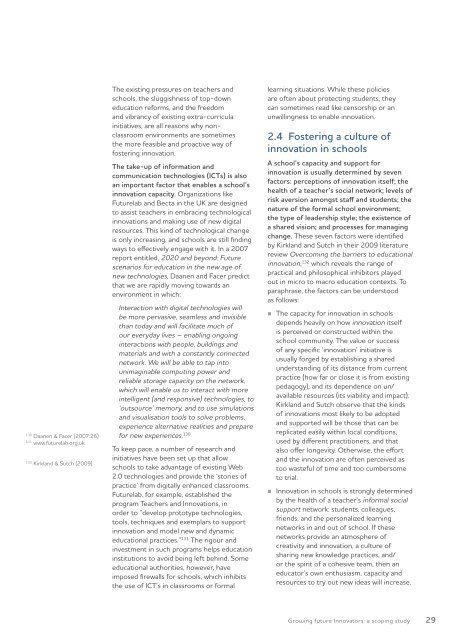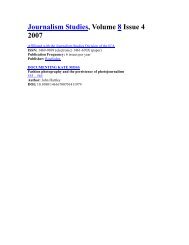GrowinG Future innovators - ARC Centre of Excellence for Creative ...
GrowinG Future innovators - ARC Centre of Excellence for Creative ...
GrowinG Future innovators - ARC Centre of Excellence for Creative ...
You also want an ePaper? Increase the reach of your titles
YUMPU automatically turns print PDFs into web optimized ePapers that Google loves.
130 Daanen & Facer (2007:26)<br />
131 www.futurelab.org.uk<br />
132 Kirkland & Sutch (2009)<br />
The existing pressures on teachers and<br />
schools, the sluggishness <strong>of</strong> top-down<br />
education re<strong>for</strong>ms, and the freedom<br />
and vibrancy <strong>of</strong> existing extra-curricula<br />
initiatives, are all reasons why nonclassroom<br />
environments are sometimes<br />
the more feasible and proactive way <strong>of</strong><br />
fostering innovation.<br />
The take-up <strong>of</strong> in<strong>for</strong>mation and<br />
communication technologies (ICTs) is also<br />
an important factor that enables a school’s<br />
innovation capacity. Organizations like<br />
<strong>Future</strong>lab and Becta in the UK are designed<br />
to assist teachers in embracing technological<br />
innovations and making use <strong>of</strong> new digital<br />
resources. This kind <strong>of</strong> technological change<br />
is only increasing, and schools are still finding<br />
ways to effectively engage with it. In a 2007<br />
report entitled, 2020 and beyond: <strong>Future</strong><br />
scenarios <strong>for</strong> education in the new age <strong>of</strong><br />
new technologies, Daanen and Facer predict<br />
that we are rapidly moving towards an<br />
environment in which:<br />
Interaction with digital technologies will<br />
be more pervasive, seamless and invisible<br />
than today and will facilitate much <strong>of</strong><br />
our everyday lives – enabling ongoing<br />
interactions with people, buildings and<br />
materials and with a constantly connected<br />
network. We will be able to tap into<br />
unimaginable computing power and<br />
reliable storage capacity on the network,<br />
which will enable us to interact with more<br />
intelligent (and responsive) technologies, to<br />
‘outsource’ memory, and to use simulations<br />
and visualisation tools to solve problems,<br />
experience alternative realities and prepare<br />
<strong>for</strong> new experiences. 130<br />
To keep pace, a number <strong>of</strong> research and<br />
initiatives have been set up that allow<br />
schools to take advantage <strong>of</strong> existing Web<br />
2.0 technologies and provide the ‘stories <strong>of</strong><br />
practice’ from digitally enhanced classrooms.<br />
<strong>Future</strong>lab, <strong>for</strong> example, established the<br />
program Teachers and Innovations, in<br />
order to “develop prototype technologies,<br />
tools, techniques and exemplars to support<br />
innovation and model new and dynamic<br />
educational practices.” 131 The rigour and<br />
investment in such programs helps education<br />
institutions to avoid being left behind. Some<br />
educational authorities, however, have<br />
imposed firewalls <strong>for</strong> schools, which inhibits<br />
the use <strong>of</strong> ICT’s in classrooms or <strong>for</strong>mal<br />
learning situations. While these policies<br />
are <strong>of</strong>ten about protecting students, they<br />
can sometimes read like censorship or an<br />
unwillingness to enable innovation.<br />
2.4 Fostering a culture <strong>of</strong><br />
innovation in schools<br />
A school’s capacity and support <strong>for</strong><br />
innovation is usually determined by seven<br />
factors: perceptions <strong>of</strong> innovation itself; the<br />
health <strong>of</strong> a teacher’s social network; levels <strong>of</strong><br />
risk aversion amongst staff and students; the<br />
nature <strong>of</strong> the <strong>for</strong>mal school environment;<br />
the type <strong>of</strong> leadership style; the existence <strong>of</strong><br />
a shared vision; and processes <strong>for</strong> managing<br />
change. These seven factors were identified<br />
by Kirkland and Sutch in their 2009 literature<br />
review Overcoming the barriers to educational<br />
innovation, 132 which reveals the range <strong>of</strong><br />
practical and philosophical inhibitors played<br />
out in micro to macro education contexts. To<br />
paraphrase, the factors can be understood<br />
as follows:<br />
The capacity <strong>for</strong> innovation in schools<br />
depends heavily on how innovation itself<br />
is perceived or constructed within the<br />
school community. The value or success<br />
<strong>of</strong> any specific ‘innovation’ initiative is<br />
usually <strong>for</strong>ged by establishing a shared<br />
understanding <strong>of</strong> its distance from current<br />
practice (how far or close it is from existing<br />
pedagogy), and its dependence on un/<br />
available resources (its viability and impact).<br />
Kirkland and Sutch observe that the kinds<br />
<strong>of</strong> innovations most likely to be adopted<br />
and supported will be those that can be:<br />
replicated easily within local conditions,<br />
used by different practitioners, and that<br />
also <strong>of</strong>fer longevity. Otherwise, the ef<strong>for</strong>t<br />
and the innovation are <strong>of</strong>ten perceived as<br />
too wasteful <strong>of</strong> time and too cumbersome<br />
to trial.<br />
Innovation in schools is strongly determined<br />
by the health <strong>of</strong> a teacher’s in<strong>for</strong>mal social<br />
support network: students, colleagues,<br />
friends, and the personalized learning<br />
networks in and out <strong>of</strong> school. If these<br />
networks provide an atmosphere <strong>of</strong><br />
creativity and innovation, a culture <strong>of</strong><br />
sharing new knowledge practices, and/<br />
or the spirit <strong>of</strong> a cohesive team, then an<br />
educator’s own enthusiasm, capacity and<br />
resources to try out new ideas will increase.<br />
Growing future Innovators: a scoping study 29




![Plebiscite (Riegert chapter) revised FINAL [Feb 14].pdf](https://img.yumpu.com/8710373/1/190x245/plebiscite-riegert-chapter-revised-final-feb-14pdf.jpg?quality=85)